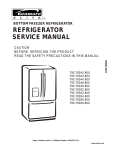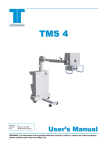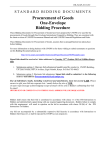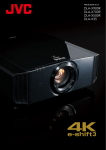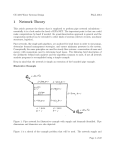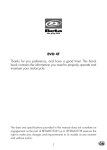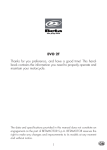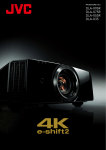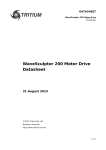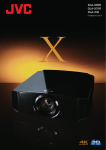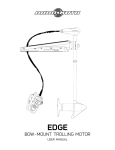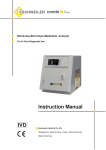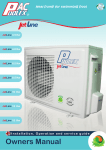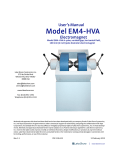Download 191 P/SP N KFC
Transcript
APPLICARE TARGA CARATTERISTICHE INSTRUCTIONS - HANDBOOK 191 P/SP N KFC 191 SP N KFC We wish to thank you for the preference granted to us by purchasing one of CARPIGIANI machines. To the best guarantee, since 1993 CARPIGIANI has submitted its own Quality System to the certification according to the international Standard ISO 9001, nowadays its production has got UNI-EN-ISO 9001-2008 Certified Quality System. Moreover, Carpigiani machines comply with following European Directives: - “Machinery” Directive 2006/42/EC, - “Low Voltage” Directive 2006/95/EC, - “EMC” Directive 2004/108/EC, - “PED” Directive 97/23/EC, - Regulation 2004/1935/EC relating to “Materials and articles in contact with foodstuffs” CARPIGIANI Via Emilia, 45 - 40011 Anzola dell'Emilia (Bologna) - Italy Tel. +39 051 6505111 - Fax +39 051 732178 This manual contains a TRANSLATION OF THE ORIGINAL INSTRUCTIONS and may not be reproduced, transmitted, transcribed, filed in a data retrieval system or translated into other languages, without the prior written permission of CARPIGIANI. The purchaser has the wright to reprint it for his own office use. CARPIGIANI policy pursues a steady reasearch and development, thus it reserves the right to make changes and revisions whenever deemed necessary and without being bound to previous statements to the purchaser. Issue: 1 Date: 2012/01 Changes: Issued by: AM Checked by: RF Approved by: RV 191 SP N KFC_EN - 2012/11 - Ed. 01 -2- 191 SP N KFC INDEX FOREWORD ....................................................................................................................... 5 INSTRUCTION HANDBOOK ................................................................................. 5 PURPOSE ...................................................................................................................5 HANDBOOK STRUCTURE .................................................................................... 5 ADDITIONAL DOCUMENTATION ....................................................................... 5 CONVENTIONAL SYMBOLS ................................................................................ 6 SYMBOLOGY QUALIFICATION OF THE STAFF ............................................... 6 SAFETY..................................................................................................................... 7 WARNING................................................................................................................. 7 SECT. 1 GENERAL 1.1 1.2 1.3 1.4 1.5 1.6 1.7 GENERAL INFORMATION ................................................................................. 9 1.1.1 MANUFACTURER'S IDENTIFICATION DATA......................................... 9 1.1.2 INFORMATION ABOUT SERVICE ............................................................. 9 1.1.3 INFORMATION TO THE USERS ............................................................... 9 INFORMATION ABOUT THE MACHINE ......................................................... 9 1.2.1 GENERAL DATA........................................................................................... 9 1.2.2 MACHINE LAY-OUT.................................................................................. 10 1.2.3 TECHNICAL FEATURES ........................................................................... 10 1.2.4 MACHINE SETS LOCATION .....................................................................11 INTENDED USE.....................................................................................................11 NOISE ......................................................................................................................11 STORING A MACHINE ........................................................................................11 DISPOSAL OF PACKING STUFFS .....................................................................11 WEEE.......................................................................................................................11 SECT. 2 INSTALLATION 2.1 2.2 2.3 2.4 2.5 2.6 ROOM NECESSARY TO THE MACHINE USE .............................................. 13 MACHINE WITH AIRCOOLED CONDENSER .............................................. 13 2.2.1 AIR FLOW................................................................................................... 13 MACHINE WITH WATERCOOLED CONDENSER ....................................... 14 2.3.1 WATER VALVE ADJUSTMENT ................................................................ 14 ELECTRIC CONNECTION ................................................................................ 14 2.4.1 REPLACEMENT OF POWER SUPPLY CORD......................................... 14 REFILLING ........................................................................................................... 15 MACHINE TESTING ........................................................................................... 15 SECT. 3 DIRECTION FOR USE 3.1 3.2 3.3 3.4 3.5 3.6 3.7 3.8 3.9 MACHINE CONFIGURATION .......................................................................... 17 ELECTRONIC CONTROL KEYBOARD AND BUTTON FUNCTION ........ 17 SPIGOT HANDLE ................................................................................................ 19 "R" PUMP.............................................................................................................. 19 PRELIMINARY OPERATION, WASHING AND SANITIZATION ............... 20 3.5.1 CLEANING .................................................................................................. 20 3.5.2 SANITIZING................................................................................................ 22 3.5.3 HYGIENE .................................................................................................... 22 STARTING THE MACHINE ............................................................................... 23 PRODUCTION ...................................................................................................... 23 PASTEURIZATION .............................................................................................. 24 OPENING PROCEDURES .................................................................................. 24 3.9.1 SANITIZATION OF THE LID AREA......................................................... 24 3.9.2 DISASSEMBLY AND CLEANING OF COMPONENTS .......................... 24 3.9.3 REASSEMBLY OF COMPONENTS .......................................................... 24 3.9.4 EXTERNAL CLEANING OF THE MACHINE ......................................... 25 -3- 191 SP N KFC_EN - 2012/11 - Ed. 01 191 SP N KFC 3.10 3.11 3.12 CLOSING PROCEDURES................................................................................... 25 3.10.1 PRE-ARRANGE THE MACHINE FOR A PASTEURISATION CYCLE OVERNIGHT ................................................................................. 25 3.10.2 DISASSEMBLY AND CLEANING OF THE TANK COVER ................... 25 3.10.3 CLEANING THE TANK ZONE .................................................................. 25 3.10.4 DISASSEMBLY AND CLEANING THE OIL DRIP DRAWERS.............. 25 3.10.5 SANITIZATION OF THE LID AREA......................................................... 25 3.10.6 CLEANING AND SANITISATION OF THE OIL DRIP TRAY ................ 25 3.10.7 EXTERNAL CLEANING OF THE MACHINE ......................................... 25 ON THE DISPLAY ................................................................................................ 26 PROGRAMMING FOR USER ............................................................................ 26 SECT. 4 SAFETY DEVICES 4.1 ALARMS ................................................................................................................ 27 4.1.1 BLACK-OUT ............................................................................................... 28 SECT. 5 CLEANOUT DISASSEMBLING AND REASSEMBLING OF PARTS IN CONTACT WITH THE PRODUCT 5.1 5.2 5.3 5.4 5.5 5.6 5.7 5.8 5.9 5.10 5.11 5.12 5.13 5.14 DAILY CLEANING............................................................................................... 30 PROGRAMMED CLEANING TIME ................................................................. 30 DRAINING AND CLEANING ............................................................................. 30 DISASSEMBLING OF THE TANK MIXER ..................................................... 31 DISASSEMBLING MIX PUMP........................................................................... 31 DISASSEMBLING OF THE DISPENSING DOOR .......................................... 32 DISASSEMBLING OF THE BEATER ............................................................... 32 WASHING AND SANITIZING OF COMPONENT PARTS ............................ 33 REASSEMBLING OF THE HOPPER MIXER ................................................. 33 REASSEMBLING MIX PUMP............................................................................ 34 REASSEMBLING OF THE BEATER ................................................................ 35 REASSEMBLING OF THE DISPENSING DOOR ........................................... 35 SANITIZING THE WHOLE MACHINE ........................................................... 36 MIX PRIMING ...................................................................................................... 36 SECT. 6 MAINTENANCE 6.1 6.2 6.3 6.4 SERVICING TYPOLOGY ................................................................................... 37 WATERCOOLING ................................................................................................ 38 AIRCOOLING ....................................................................................................... 38 TABLE OF SPARE PARTS EQUIPMENT ......................................................... 39 SECT. 7 TROUBLESHOOT GUIDE 7.1 191 SP N KFC_EN - 2012/11 - Ed. 01 TROUBLESHOOT GUIDE .................................................................................. 41 -4- 191 SP N KFC FOREWORD INSTRUCTION HANDBOOK Editing this handbook, it was taken into due account European Community directions on safety standards as well as on free circulation of industrial products within E.C. PURPOSE This handbook was conceived taking machine users' needs into due account. Topics relevant to a correct use of the machine have been analyzed in order to keep unchanged in the long run quality features charachterizing CARPIGIANI machines all over the world. A significant part of this handbook refers to the conditions necessary to the machine use and to the necessary procedure during cleanout as well as routine and special maintenance. Nevertheless, this handbook cannot meet all demands in details. In case of doubts or missing information, please apply to: CARPIGIANI Via Emilia, 45 - 40011Anzola dell'Emilia (Bologna) - Italy Tel. +39 051 6505111 - Fax +39 051 732178 HANDBOOK STRUCTURE This handbook is divided in sections, chapters and subchapters in order to be consulted more easily. Section A section is the part of the handbook identifying a specific topic related to a machine part. Chapter A chapter is that part of a section describing an assembly or concept relevant to a machine part. Subchapter It is that part of a chapter detailing the specific component of a machine part. It is necessary that each person involved in the machine operation reads and clearly understands those parts of the handbook of his/her own concern, and particularly: The Operator must read the chapters concerning the machine star-up and the operation of machine components. A skilled technician involved in the installation, maintenance, repair, etc., of the machine must read all parts of this handbook. ADDITIONAL DOCUMENTATION Along with an instruction manual, each machine is supplied also with additional documentation: Part list: A list of spare parts which is delivered together with the machine for its maintenance. Wiring diagram: A diagram of wiring connections is placed in the machine. Before using the machine read carefully the instruction handbook. Pay attention to the safety instructions. -5- 191 SP N KFC_EN - 2012/11 - Ed. 01 191 SP N KFC CONVENTIONAL SYMBOLS CAUTION: ELECTRIC SHOCK DANGER The staff involved is warned that the non-obsevance of safety rules in carrying out the operation described may cause an electric shock. CAUTION: GENERAL HAZARD The staff involved is warned that the operation described may cause injury if not performed following safety rules. NOTE It points out significant information for the staff involved. WARNINGS The staff involved is warned that the non-observance of warning may cause loss of data and damage to the machine. PROTECTIONS This symbol on the side means that the operator must use personal protection against an implicit risk of accident. SYMBOLOGY QUALIFICATION OF THE STAFF The staff allowed to operate the machine can be differentiated by the level of preparation and responsibility in: MACHINE OPERATOR Identify unqualified personnel, those without any specific technical abilities who are capable of carrying out simple jobs, such as: operating the machine using the commands available on the keypad, the loading and unloading of products used during production, the loading of any consumable materials, basic maintenance operations, (cleaning, simple blockages, controls of the instrumentation, etc.). MAINTENANCE ENGINEER He/she is a skilled engineer for the operation of the machine under normal conditions; he/she is able to carry out interventions on mechanical parts and all adjustments, as well as maintenance and repairs. He/she is qualified for interventions on electrical and refrigeration components. CARPIGIANI ENGINEER He/she is a skilled engineer the manufacturer assigned to field interventions for complex jobs under particular conditions or in accordance with agreements made with the machine's owner. 191 SP N KFC_EN - 2012/11 - Ed. 01 -6- 191 SP N KFC SAFETY When using industrial equipment and plants, one must be aware of the fact that drive mechanisms (rotary motion), high voltage components, as well as parts subject to high temperatures may cause serious damage to persons and things. Who is in charge of plant safety must be on the look-out that: an incorrect use or handling shall be avoided; safety devices must neither be removed nor tampered with; the machine shall be regularly serviced; only original spare parts are to be used especially as far as those components with safety functions are concerned (ex.: protection microswitches, thermostats); suitable personal protective equipment is worn. To achieve the above, the following is necessary: at the working place an instruction manual relevant to the machine should be available; such documentation must be carefully read and requirements must conse quently be met; only adequately skilled personnel should be assigned to electrical equipment; IMPORTANT! One must be on the look-out that the staff does not carry out any operation outside its own sphere of knowledge and responsibility (refer to “Symbology qualification of the staff”). NOTE: According to the standard at present in force, a SKILLED ENGINEER is who, thanks to: - training, experience and education, - knowledge of rules, prescriptions and interventions on accident prevention, - knowledge of machine operating conditions, Is able to realize and avoid any danger and has also been allowed by the person in charge of plant safety to carry out all kinds of interventions. WARNING When installing the machine, insert a differential magnetothermal protection switch on all poles of the line, adequately sized to the absorption power shown on machine data plate and with contact opening of 3 mm at least. Never put your hand into the machine, alike during production and cleaning operations. Before carrying out any maintenance operation, make sure that the machine is in “STOP” position and main switch has been cut out. It is forbidden to wash the machine by means of a bolt of water under pressure. It is forbidden to remove panels in order to reach the machine inside before having disconnected the machine. CARPIGIANI is not responsible for any accident that might happen during operation, cleaning and/or servicing of its units, if this warning has not been fully complied with. -7- 191 SP N KFC_EN - 2012/11 - Ed. 01 191 SP N KFC 191 SP N KFC_EN - 2012/11 - Ed. 01 -8- 191 SP N KFC 1. GENERAL INFORMATION 1.1 GENERAL INFORMATION 1.1.1 Manufacturer's identification data The machine has a data plate carrying manufacturer data, machine type and serial number, assigned when it is manufactured. Copy of machine data plate to be found on first page of this handbook. A B F G LEGEND: 100089654588-4 ANZOLA EMILIA - BOLOGNA - ITALY Matr. Cod. V A kg Gas C D E Hz kW A= Serial number B= Machine type C= Voltage D= Main-switch amperometric value E= Gas type and weight F= Machine code G= Condensation H= Frequency I= Power input I H 1.1.2 Information about service All operations of routine maintenance are here described in section "Maintenance"; any additional operation requiring technical intervention on the machine must be cleared with the manufacturer, who will also examine the possibility of a factory technician field intervention. 1.1.3 Information to the user The manufacturer of the machine is at user's disposal for any explanation and information about the machine operation. In case of need, please call the local distributor, or the manufacturer if no distributor is available. Manufacturer's service department is available for any information about operation, and requests of spare parts and service. 1.2 INFORMATION ABOUT THE MACHINE 1.2.1 General data Counter-top machine to immediately produce and distribute soft express ice cream in one flavor available with grabity feeder or pump to ensure a grater increase of volume. CARPIGIANI recommends to always use high quality mix for ice cream production in order to satisfy your customers, even the most hard-to-please ones. Any saving made to the prejudice of quality will surely turn into a loss much bigger than the saving itself. -9- 191 SP N KFC_EN - 2012/11 - Ed. 01 191 SP N KFC Bearing in mind the above statements, please take heed of the following suggestions: - Make your mixes yourselves from high quality natural ingredients or buy them from reliable companies. - Follow closely instructions given by your mix supplier for the preparation of the mixes. - Do not alter your mix supplier's recipies, by adding, for instance, water or sugar. - Taste ice cream before serving it and start selling it only if entirely satisfactory. - Make sure your staff always keeps the machine clean. - Have your machine serviced always by companies authorized by CARPIGIANI. 1.2.2 Machine layout 80 m (3 m in ) mm 8 0 in ) (3 mm in ) (3 710 mm (28 in) 80 56 67 5m 0m m m (2 6 (2 2 ,5 in) in ) 50 5m m (2 0 in ) Fig. 1 1.2.3 Technical features MODEL 191 P/SP N * Hourly production * 120 ml - 0,03 gal portions Hopper capacity liters/gal 250 12 Installed power Volt Phase Cycle kW/Hp Net weight Kg/lb 400 3 50 2,1 143 Electrical supply Flavors 1 Hour output may vary depending on mix used Performances featured by a room temperature of 25°C and a water temperature of 20°C. 191 SP N KFC_EN - 2012/11 - Ed. 01 - 10 - 191 SP N KFC 1.2.4 Machine sets location 4 Caption: 1 Control panel 2 Freezing cylinder front lid 3 Drip tray shelf 4 Mix tank cover 5 Oil drip drawer 1 2 3 5 Fig. 2 1.3 INTENDED USE The machines must be used solely for the purpose described in chapter 1.2.1, "General information" within the functional limits decribed below. Voltage: Min air temperature °C: Max air temperature °C: Min water temperature: Max water temperature: Min. water pressure: Max water pressure: Max relative humidity: ±10% 10°C 43°C 10°C 30°C 0,1 MPa (1 bar) 0,8 MPa (8 bar) 85% The machine has been designed for its use in places which are not subject to explosion-proof standards; its use is thus bound to conforming places and normal atmospher. 1.4 NOISE The steady acoustic pressure level weighed A in a working place alike by watercooled and by aircooled machines is less than 70 dB(A). 1.5 STORING A MACHINE The machine must be stored in a dry and dump-free place. Before storing the machine, wrap it in a cloth in order to protect it against dust and else. 1.6 DISPOSAL OF PACKING STUFFS When opening the packing crate, divide packing stuffs per type and get rid of them according to laws in force in machine installation country. 1.7 WEEE (Waste Electrical and Electronic Equipment) In conformity with the European Directives 2006/66/EC, on batteries and accumulators and waste batteries and accumulators, and 2002/96/EC, also known as WEEE, the presence of the symbol on the side of the product or packaging means that the product must not be disposed of with normal urban waste. Instead, it is the user’s responsibility to dispose of this product by returning it to a collection point designated for the recycling/treatment of electrical and electronic equipment waste. Differentiated collection of this waste material helps to optimize the recovery and recycling of any reclaimable materials and also reduces the impact on human health and the environment. For more information concerning the correct disposal of this product, please contact your local authority or the retailer where this product was purchased. - 11 - 191 SP N KFC_EN - 2012/11 - Ed. 01 191 SP N KFC 191 SP N KFC_EN - 2012/11 - Ed. 01 - 12 - 191 SP N KFC 2. INSTALLATION 2.1 ROOM NECESSARY TO THE MACHINE USE The machine must be installed in such a way that air can freely circulate allaround. Rooms for the approach to the machine must be left free in order to enable the operator to act without constraint and also to immediately leave working area, if need be. ATTENTION Machines with aircooled condenser must be installed no closer than 8 cm to any wall in order to allow free air circulation around the condenser. NOTE An insufficient air circulation affects operation and output capacity of the machine. 80 m (3 m in ) mm 8 0 in ) (3 80 mm in ) (3 Fig. 3 2.2 MACHINE WITH AIRCOOLED CONDENSER Machines with aircooled condenser must be installed no closer than 8 cm to any wall in order to allow free air circulation around the condenser. NOTE An insufficient air circulation affects operation and output capacity of the machine. 2.2.1 Air flow The machine is provided with an internal fan motor which takes fresh air from the right panel of the machine and exhausts the heated air through the left and rear panels of the machine. IMPORTANT Do not place topping containers, syrup containers or other products, in front of the left panel of the machine because the hot air flow increases the temperature of the products or may melt them. NO topping OK topping AIR IN AIR OUT Fig. 4 - 13 - 191 SP N KFC_EN - 2012/11 - Ed. 01 191 SP N KFC 2.3 MACHINES WITH WATERCOOLED CONDENSER To make the machine run, a watercooled machine must be connected to running water supply, or to a cooling tower. Water must have a pressure of 1 Bar at least and a delivery at least equal to the estimated hourly consumption. Connect inlet pipe marked by plate "Water Inlet" to water supply installing a shut-off valve, and outlet pipe marked by plate "Water Outlet" to a drain pipe, installing a shut-off valve. 2.3.1 Water valve adjustment WARNING If water valve must be retarded, this operation will have to be carried out by skilled personnel, only. Valve adjustment must be carried out in such a way that no water flows when machine is off and lukewarm water flows when machine is on. NOTE: Water consumption increases if temperature of entering water is above 20°C. ATTENTION: Do not leave the machine in a room with temperature below 0°C without first draining water from the condenser. 2.4 ELECTRIC CONNECTION Before connecting the machine to the mains, check that machine voltage indicated in data plate corresponds with the mains (see sec. 1.1.1 point C). Insert a differential magnetothermal protection switch adequately sized to absorption capacity required (see sec. 1.1.1 point D) and with contact opening of 3 mm at least. WARNING Yellow/green ground wire must be connected to a good ground outlet. Rotation direction by three-phased machines The beater rotates anticlockwise. By gravity-feed machines, it is necessary to remove the plate and check the direction of rotation, whereas by machines with pump you shall check whether the mix comes out from delivery hole when removing the compression pipe. Reversing rotation direction To reverse the direction rotation, when wrong, it is necessay to interchange two of the three leads coming from the circuit breaker. 2.4.1 Replacement of power supply cord If the machine main cable is damaged, it must be replaced through a cable with similar features. Replacement will have to be carried out by skilled technicians only. 191 SP N KFC_EN - 2012/11 - Ed. 01 - 14 - 191 SP N KFC 2.5 REFILLING Motor installed in the machine is of the type with lubrication for life; no action of checking/replacing or topping up is necessary. Gas filling necessary to the freezing system is carried out at CARPIGIANI works during machine postproduction testing. If a gas addition happens to be made, this must be carried out by skilled technicans, only, who can also find out trouble origin. 2.6 MACHINE TESTING A postproduction test of the machine is carried out at Carpigiani premises; Operation and output functionality of the machine are thoroughly tested. Machine test at end user's must be carried out by skilled technicians or by one of CARPIGIANI engineers. After the machine positioning and correct connections, also carry out all operations necessary to functional check and test of the machine. - 15 - 191 SP N KFC_EN - 2012/11 - Ed. 01 191 SP N KFC 191 SP N KFC_EN - 2012/11 - Ed. 01 - 16 - 191 SP N KFC 3. DIRECTION FOR USE 3.1 MACHINE CONFIGURATION The machine has a motor to drive the beater, and a cooling system with water or air condenser. Soft ice cream is prepared by filling the tank with cold mix (+4°C) and starting the automatic production cycle, until the ideal ice cream consistency set by CARPIGIANI is reached. Thanks to the pump or to the feeding needle, the mix enters the freezing cylinder already mixed with air; ice cream is produced only when it needs to be served. The spigot head allows a single portion of soft ice cream to be distributed. At the same time, the same amount of mix moves from the hopper into the freezing cylinder. Fig. 5 3.2 ELECTRONIC CONTROL KEYBOARD AND BUTTON FUNCTIONS Details of the panel are shown in the picture below. Fig. 6 - 17 - 191 SP N KFC_EN - 2012/11 - Ed. 01 191 SP N KFC STOP button By pressing this push-button during operation, the machine stops (LED on). DISPLAY 10:33:21 Fri 10:33:21 Fri Overload Beater Comments When the machine is in STOP, the display shows Time and Date. In case we have an ALARM activated, the backlight of the LCD display will flash, and the display indicates the kind of ALARM. PRODUCTION button Press PROD button to start the production mode (LED on). The motor and compressor are automatically controlled by HARD-O-TRONIC system. By pressing this button from STOP, the display indicates: 1 DISPLAY Do Not Serve ! Wash in 14 days Comments When the sundae is not ready, the display shows: “DO NOT SERVE“ Sundae Ready ! Wash in 14 days When the sundae has reached the desired consistency the display shows “READY“ Do Not Serve ! Overload Beater In case of ALARM, this will be displayed on the second row. While in Prod mode, we can go to the next page of the display by pushing PROD key. Temperatures are indicated. Pushing PROD again, we move to the next page showing actual consistence and the SET to be reached. Hopper +14c Cylinder +13c 2 Set=090 Hot=085 3 4 Cones today 1543 Pushing PROD again, we move to the next page showing the daily cone counter 5 Total Cones 123456789 Pushing PROD again, we move to the next page showing the TOTAL cones counter 6 TEV=+10 TGV=-22 TEC=+13 TE1=-12 Pushing PROD again, we move to the next page showing the temperature in the hopper, in the cylinder, .. TET=+60 Pushing PROD again, we move to the next page showing the actual Topping temperature 7 Pushing PROD again, we move to the next page that is the first page. AGITATION button By pressing this button from STOP, the led turns on. The beater and the mix pump motor get ON until you press STOP or after 3 minutes. The display indicates: DISPLAY HOT=058 TEC=+13 Comments Pushing one time this button, the beater motor and the mix pump motor will turn ON. 2 HOT=058 TEC=+13 Beater Motor OFF Pushing a second time this button, the Beater motor will STOP whereas the mix pump remains ON. 3 HOT=058 TEC=+13 Pump Motor OFF Pushing a third time this button, the Pump motor will STOP whereas the beater motor is reactivated. HOT=058 TEC=+13 Beater+Heating Pushing this button for the fourth time the beater motor remains ON and the heating is activated as well to help the product to melt. 1 4 191 SP N KFC_EN - 2012/11 - Ed. 01 - 18 - 191 SP N KFC LOCK button To clean the keyboard panel with a clean towel it is recommended to block the keys of the keyboard as follows: Push for 3 seconds LOCK button, the respective led will flash indicating that the keyboard is blocked. At this stage you can clean the keyboard without any risk. To reactivate the keyboard push for 3 seconds LOCK button, the led will get off. PASTORIZATION button / INCREASE button This program cannot be started if the hopper is less than half full of mix. The mix both in the hopper and the cylinder is heated to 65° C and kept at this temperature for 30 minutes (fixed). It is then cooled until it reaches storage temperature. At the end of the program, the display shows “- Pasto End -” along with the time and day of the week, meaning that Pasteurization has been completed successfully Pasteurization occurs every day at 2:00am (if the time is programmed at step Start Pasto Time). Normally the machine is in Production mode. When the scheduled Pasteurization time arrives, the machine automatically shifts from Production to Pasteurization. To run Manual Pasteurization press and hold the Pasteurization button for five seconds. If Pasteurization does not conclude successfully, the machine cannot access Production mode until a Pasteurization cycle has been completed correctly. This button is used to increase the value in the manager menu STORAGE button / DECREASE button / RESET ALARM MESSAGE The machine preserves the mix at +2°C (35°F) in the hopper and in the cylinder. - this button is used to decrease the value in the manager menu - this button is also used to RESET the ALARM MESSAGES on the display. MIX LEVEL SIGNAL In the hopper we have 2 level sensors: MEDIUM level and LOW level. - When the MIX LEVEL LED flashes, it means that the mix level in the hopper is lower than the medium mix level sensor. - When the MIX LEVEL LED is on, it means that the mix level in the hopper is lower than the minimum mix level sensor. The display indicates ADD MIX or MIX OUT When the LCD back light is blinking, that means an alarm has tripped. When it becomes solid, the alarm which has previously tripped, has automatically reset and the indication on the display must be reset by pressing RESET button. 3.3 SPIGOT HANDLE In order to dispense the product, place a cup or a cone under the spout and slowly pull down the disepnsing handle (pos. 5). As son as the product comes out, twist the cup or the cone to form a cone-shaped serving. When the portion has reached the desired size, close the dispensing handle and quickly pull the cone or the cup down in order to sharpen the tip. WARNING It is important to keep the sensor (pos. 920) clean. 5 920 Fig. 7 - 19 - 191 SP N KFC_EN - 2012/11 - Ed. 01 191 SP N KFC 3.4 "R" PUMP "R" pump allows, by changing position of regulator pos. 271, to vary proportions between air and mix conveyed to the freezing cylinder; so, within certain limits, it allows overrun regulation depending on mix used. "R" pump regulator should be set to the middle position. If, after dispensing a significant number of cones, ice cream is too heavy and wet, you may move the R pump regulator a notch at a time towards the right. If ice cream comes out of spigot mixed with air bubles, then turn R pump regulator a notch at a time towards the left. 271 Fig. 8 3.5 PRELIMINARY OPERATIONS, WASHING AND SANITIZATION Before starting the machine for the first time, it is necessary to thoroughly clean its parts and sanitize all parts coming into contact with the mix. WARNING The machine is equipped with an automatic system wich calls for washing of the parts in contact with the mix. Cleanout and sanitization must be carried out at the programmed date indicated on the display (for example every 14 days), as a habit and with utmost care, in order to secure quality of production in the observance of healthy rules. WARNING Never use solvents, alcohol or detergents that could damage the machine parts or pollute the parts that serve for production. 3.5.1 Cleaning Lift tank cover and from its inside take out bag containing accessories, instruction booklet and warranty sheet. Remove the tank cover. Remove the hopper agitator (pos. 162) by pulling it upwards. 162 Fig. 10 191 SP N KFC_EN - 2012/11 - Ed. 01 - 20 - 191 SP N KFC Removing pump - Disconnect the connection pipe (pos. 207) by turning it to match with the hole and free it from the pin found on the pump cover. - Pull the connection pipe backwards and remove the feeding pipe (pos. 32) by turning it 90° then pulling upwards. - Removing the pump by turning it clockwise of 45° then pull backwards. - Disassemble the pump (see section 5 of this manual). 96 39J 39 243 248J 248 1178 38A 202 1117 207 1126 550 38 245 8B 206 1126 32 271 1131 Removing the door (see section 5) Remove the two retaining knobs (pos. 8A) and pull the door assembly towards you sliding it off the two front panel studs. Pull the dispensing handle (pos. 5) so the piston (pos. 30) raises in its housing. Remove the pivot pin O-ring (pos. 1285) and pull the pivot pin (pos. 6) out releasing the dispensing handle (pos. 5). Using the dispensing handle lever pull the piston (pos. 30) out completely. Using the o-ring extractor, remove the two piston o-rings (pos. 1153), and the large dispensing door o-ring (pos. 1188). 30 1188 1153 1285 6 5 7 8A Removing the beater (see section 5) Pull the beater out of the cylinder. Slide the beater seal (pos. 28) out of the beater shaft. Pull the idler (pos. 24) slightly to the front of the beater until the groove in the shaft of the idler lines up with the slot on the beater frame. Pull the idler out. 028 024 - 21 - Fig. 15 191 SP N KFC_EN - 2012/11 - Ed. 01 191 SP N KFC 1. 2. 3. 4. Fill a sink with a detergent solution. Wash the components with the detergent solution. Fill the sink with sanitising solution. Immerse the disassembled components in the sanitising solution and let the solution act on the components. 5. Place the parts on a clean surface and leave them to dry. 6. Dip one of the brushes provided in the solution and clean the walls of the cylinder. 7. Dip one of the brushes provided in the solution and clean the holes where the pump, pressure pipe are housed inside the tank. 8. Spray the sanitizing solution on the back of the cylinder and the walls of the tank. Repeat steps 6, 7, and 8 several times. Replace the hopper agitator (pos. 162) back in its seat. Reassemble and place the compression tube (see section 5 of this manual) into the tank and connect to the pump only when cleaning operations are complete. Reassemble the pump (see section 5 of this manual), making sure to use food-grade lubricant on all o-ring and insert it in the hopper. Reassemsble the beater (see section 5 of this manual), insert it completly into the freezing cylinder by grasping it with both hands. WARNING Insert the beater minding not to hit it against the cylinder wall, since you might scratch it and so jeopardize the correct machine operation. Reassemble the front lid (see section 5 of this manual) and install it back. Place the cover back. 3.5.2 Sanitizing Before it can be used, the machine must first be sanitized. Proceed as follows: 1. Fill the tank up to the maximum level with sanitizing solution prepared in water (45-60°C), and allow the solution to flow into the cylinder. 2. Using the cleaning brushes provided, clean the mix level sensor, the walls of the tank, the pump or the tank beater. 3. Select the cleaning function and operate the machine for 10 seconds. Press the STOP button. The cylinder and pump will now be full of sanitizing solution. 4. Fill a bucket with sanitizing solution. 5. Dip a brush into the solution and clean the door. Repeat this operation twice. 6. Clean the outside of the machine with a cloth soaked in sanitizing solution. Repeat the operation twice. 7. Wait 5 minutes before proceeding with the following operations. 8. Place a bucket under the door and lower the distribution lever. 9. Wait for the solution to flow out; if it does not do so completely, leave the distribution lever down and select the CLEANING function. Operate the machine for 5 seconds to bleed out the solution completely and then press STOP. CAUTION Do not keep the beater running for more than the time strictly needed to complete washing and sanitization. Without the lubrification of mix butterfatu the beater wear out quickly. 10. Rinse the machine by filling the cylinder with drinking water. 11. Drain out the water from the cylinder by lowering the distribution lever. 3.5.3 Hygiene Mildew and bacteria grow rapidly in the ice cream fat contents. To eliminate them, it is necessary to thoroughly wash and clean all parts in contact with mix and ice cream, as described above. Staineless steel and plastic materials, as well as rubber used in the construction and also their particular shapes make cleanout easy, but cannot prevent proliferation of mildew and bacteria if not properly cleaned. 191 SP N KFC_EN - 2012/11 - Ed. 01 - 22 - 191 SP N KFC 3.6 STARTING THE MACHINE After installing the machine according to the instructions contained in the chapter INSTALLATION, and after carefully cleaning and sanitizing the machine, proceed as follows: Remove the compression pipe from bottom of the tank and place it in the sanitizing solution. Prime Hopper: • Retrieve 1 bag of mix from the walk-in refrigerator. NB.: Mix to be poured at a temperature of 4-5°C. • With the draw handle open, pour one bag of mix into the hopper and allow the mix to pass also into the freezing cylinder. The mix level in the tank must never reach the pump (see photo) and more mix must be added when the level goes below approximately 2 cms from the tank bottom. • When only a full strength mix is flowing from the draw spout, bringing with it eventual residues of sanitizer, close the draw handle. Fig. 16 Connect the mix pressure pipe: • When the mix stops bubbling from the bottom of the hopper, take the mix pressure pipe from the sanitizing solution and insert it in its position in the bottom of the hopper. Make sure your hands are clean and sanitized. • Rotate the compression tube in a clockwise direction towards the pump and connect it to the pump and rotate the connection tube (pos. 207) to block it. The level of the mixture in the vat must never reach the pump (see figure). It is also necessary to add mixture when the level has dropped to approximately 2 cms from the bottom. • Reposition the vat cover. • Select the production function. 3.7 PRODUCTION Dispense icecream without exceeding the machine production rate as shown in the table on page 13. If you do not exceed it, and provide to refill the machine with fresh mix, you can be sure you will never have to stop selling, even during peak hours. While your store is closed, set the machine to STORAGE by pushing SELECTION push-button. You will save significantly on energy consumption, as the compressor runs only for the time strictly necessary in order to keep product at its correct temperature. When you reopen the store, assure that the heat-treatment has been correctly completed and no malfunction has occurred, set the machine to STOP and then to PRODUCTION. Within a few minutes icecream will be back at the correct consistency for sale. It is essential that you carry out CLEANING and SANITIZATION of the machine, every few days, depending on bacteriological quality of your mix as well as on health regulations in force in your country. If the machine has been stopped a long time due to a power failure, it is necessary that you check product temperature before starting the sale again; if the temperature is over +6°C, the machine must be emptied, cleaned and sanitized, and filled up with new fresh mix at +4°C. - 23 - 191 SP N KFC_EN - 2012/11 - Ed. 01 191 SP N KFC 3.8 PASTEURIZATION When you stop production, mix in tank and in cylinder must be pasteurized: to do that, press STOPand then SELECTION till the led relevant to PASTEURIZATION function switches on. The machine can also be programmed to carry out pasteurisation automatically whilst the premises are closed and on a time scale set in the programme of the machine (by the technician). It is anyway necessary that the mix inside the tank is over the half of tank capacity (mean level should be thus covered). The machine automatically executed heating and cooling programs and then stores the product at +4°C. In the event of a black-out during the pasteurization cycle, the machine will automatically carry out the program. On reopening your shop, assure that the heat-treatment has been correctly completed and no malfunction has occurred, press STOP and then select the production function; within a few minutes ice cream will reach its right consistency to be served. In the event of extended power failure, it is utmost necessary that, before dispensing ice cream again, the temperature of the mix inside the tank is checked, so as to pasteurize the mix in case it is beyond 6°C. If the power failure lasts several hours, it is then necessary to clean the machine and refill with fresh mix. 3.9 OPENING PROCEDURES ATTENTION Ensure that your hands are thoroughly clean and sanitized before proceeding with the following operations. • Check that the Pasteurisation cycle has been totally completed and that the message “END” has appeared on the display. This message indicates that the pasteurisation process has been completed correctly without interruptions and the machine is ready for production. Press the Stop key and put the machine into production. ATTENTION If the Pasteurisation cycle has not been completed, the machine is blocked and access cannot be gained to production. The mix has not been correctly pasteurized. Check why the pasteurization has not been carried out by reading the alarm messages on the display. If necessary, contact Technical Assistance. Press the Stop key and the arrow key to select the pasteurization function and carry out a manual pasteurization cycle. If the pasteurization cycle is completed successfully, the blockage automatically resets and the machine is ready to start production. No product can be dispensed during the pasteurization cycle. 3.9.1 Sanitization of the lid area • Fill a bucket with sanitising solution. Immerse the brush into the sanitising solution and accurately clean the dispenser zone, the dispenser spout, the handle and the area surrounding the piston. • Spray sanitizing solution over the tap zone, handle, dispenser spout and inside the lid hole. ATTENTION Do not spray sanitising solution directly onto the photocell underneath the door. 3.9.2 Disassembly and cleaning of components Remove the oil drip tray, the oil drip drawers and the tank cover. Wash, rinse and sanitise them. Reassemble the components after sanitisation. 3.9.3 Reassembly of components Reassemble the oil drip tray, the oil drip drawers and the tank cover after sanitization. 191 SP N KFC_EN - 2012/11 - Ed. 01 - 24 - 191 SP N KFC 3.9.4 External cleaning of the machine Using a clean and sanitised cloth, clean the door area, the front panel and any other areas that come into contact with the product. 3.10 CLOSING PROCEDURES ATTENTION Ensure that your hands are thoroughly clean and sanitized before proceeding with the following operations . 3.10.1 Pre-arrange the machine for a pasteurisation cycle overnight - Open the lid and check the level of mix in the tank. - Add mix if necessary. The LED of the tank level indicator must be off. The level of the mix in the tank must never reach the pump. - Ensure that the machine is in Distribution mode (the relative LED must be alight). 3.10.2 Disassembly and cleaning of the tank cover Disassemble the tank cover and wash, rinse and sanitise it. 3.10.3 Cleaning the tank zone Using a clean and sanitised cloth, accurately clean the external zone of the tank. Ensure that no debris drops into the tank. Reposition the sanitised tank cover on the tank. 3.10.4 Disassembly and cleaning the oil drip drawers Remove the two oil drip drawers from the side of the machine. Wash, rinse, sanitise and reassemble them. 3.10.5 Sanitization of the lid area • Fill a bucket with sanitising solution. Immerse the brush into the sanitising solution and accurately clean the dispenser zone, the dispenser spout, the handle and the area surrounding the piston. • Spray sanitizing solution over the tap zone, handle, dispenser spout and inside the lid hole. ATTENTION Do not spray sanitising solution directly onto the photocell underneath the door. 3.10.6 Cleaning and sanitisation of the oil drip tray After sanitising the door area, remove the oil drip tray and wash, rinse and sanitise it. Replace it on the machine. 3.10.7 External cleaning of the machine Using a clean and sanitised cloth, clean the door area, the front panel and any other areas that come into contact with the product. - 25 - 191 SP N KFC_EN - 2012/11 - Ed. 01 191 SP N KFC 3.11 ON THE DISPLAY In order to read the events, the machine should be in STOP then push EVENTS**** is displayed. until ****READ 02:00:00 06 APR START PROD. The first event will appear on the display. Push INCREASE or DECREASE in order to scroll UP or DOWN the events list. Push STOP to exit the events reading and go to STOP. 3.12 PROGRAMMING FOR USER 1) To access the Manager Menu push simultaneously both keys and then release immediately. On the display you will read the first step of the Manager Menu: Step U01 Hour 10 The first row indicates the step number, and the second row indicates the description and value. 2) Push INCREASE or DECREASE in order to increase or decrease the value. 3) Push STOP to move to the next step. 4) To exit the Manager Menu push AGITATION key. The following table illustrates all the steps of the manager menu: Step (first row) U01 U02 U03 U04 U05 U06 U07 U08 U09 U10 191 SP N KFC_EN - 2012/11 - Ed. 01 Display ENG (secondo row) Hours Minutes Day of Week Day of Month Month Year Language Start Prod. Time Start Past/Stor Time Lev. Beep Enable Min Max Default 00 00 Sun 01 Jan 2000 Eng 00 00 No 23 59 Sat 31 Dec 2099 Eng 23+no 23+no Yes Eng 08 02 Yes - 26 - 191 SP N KFC 4. SAFETY DEVICES 4.1 ALARMS The machine is provided with a self-diagnosis function, which indicates any failure during operation. The display blinks when an alarm is active and becomes on solid if an alarm was detected and then reset. Push RESET button in order to refresh the display when the alarm has been reset. Use the following table to determine whether a service call is required (critical alarm). If a service call is required, write down the alarm message and inform the service company. The machine can dispense product in case a non-critical alarm is active. ALARM DESCRIPTION Add Mix Mix level is lower than the medium level sensor Mix Out Mix level is lower than the low level sensor Overload beater (RTA) Thermal relay of beater motor has tripped Pressure Switch (PR) Pressure switch for high gas pressure has tripped. Overload Compres RTC Thermal relay of compressor motor has tripped. Al. Hopper probe (TEV) Hopper temperature sensor is out of order. Al. Cylind. Probe TEC Cylinder temperature sensor is out of order Al. IceHop. Probe TGV Hopper evaporator sensor is out of order Spigot Opened (IMS) Faceplate is open or disassembled. Al Evapor.Probe (TE) Temperature probe on cylinder out of order Power on A black out has occurred Ice Cylinder (ICE) Bad heat exchange in the cylinder, Timeout Prd. Cooling problem, the product is not getting hard while cooling; Belt Alarm The hopper agitator is not turning, Wash In n days It indicates the days remaining for next cleaning; when wash today appears the machine must be disassembled, cleaned and sanitized. Press RESET button to reset the message on the display. Do Not Serve! Product under process; - 27 - 191 SP N KFC_EN - 2012/11 - Ed. 01 191 SP N KFC 4.1.1 Black-out In the event of a black-out with the machine in: • AGITATION • HEAT-TREATMENT (HEATING or PAUSE stage) the machine will resume operating in the same function where it was when the power went off. If the machine was in one of the following functions: • STORAGE • PRODUCTION • HEAT-TREATMENT (COOLING stage) upon the return of power, the temperature at the time of failure and the duration of the black-out will be automatically checked and the machine will resume operating in the same function or it will start a new HEAT-TREATMENT cycle, in accordance with the applicable safety standards: CAUTION If a blackout exceeds four hours, it is always necessary, to avoid health hazards in the dispensed product, to disassemble, to wash, to rinse and to sanitize the parts as indicated in Section 5 of this manual. 191 SP N KFC_EN - 2012/11 - Ed. 01 - 28 - 191 SP N KFC 5. CLEANOUT DISASSEMBLING AND REASSEMBLING OF PARTS IN CONTACT WITH THE PRODUCT IMPORTANT Cleanout and sanitation must be carried out at the end of every working day as a habit and with utmost care in order to guarantee the production quality in the observance of necessary healthy rules. If dirt is left enough time to dry out, this increases the risk of stains, marks and damage to surfaces. Removing dirt is much easier if done immediately after use and since there is also a risk that some elements containing acid or saline substances can damage the surfaces, prolonged soaking is not recommended. WARNING Never use solvents, alcohol, or detergents that can damage the machine parts or pollute production functional parts. Never use powder or abrasive cleaning products, scourers or pointed tools when cleaning by hand; there is a risk of leaving the surfaces opaque or of removing or weakening the protective film on the surface, scratching it. Never use metal or synthetic scouring pads under any circumstances to prevent any abrasion or removal of ferrous parts leading to problems of surface oxidation or weakening. Do not use detergents containing chlorine or chlorine compounds; using these detergents, which include bleach, ammonia, hydrochloric acid and scale removers can attack the steel compound used, causing it to stain or oxidize permanently. At the end of washing and before refitting any parts, always dry them with a clean, soft cloth that is suitable for use with foods; this is necessary even after a drying cycle in the dishwasher, since any type of moisture with a high mineral or chlorine content can attack metal surfaces and leave opaque traces. - 29 - 191 SP N KFC_EN - 2012/11 - Ed. 01 191 SP N KFC 5.1 DAILY CLEANING Refer to the opening procedures (par. 3.9) and closing procedures (par. 3.10). 5.2 PROGRAMMED CLEANING TIME The machine is equipped with an automatic system wich calls for washing of the parts in contact with the product for example every 14 days. This system, identified as "WASH", disables the dispensing function at the end of the fourteenh day after the latest cleaning. On the display, the message " " appears. Every time the product is dispensed or the beater motor is activated, the display shows the number of days to the next cleaning date, as follows: DAY MESSAGE 3 days before -3 2 days before -2 1 day before -1 Disabling day WARNING Cleanout and sanitization must be carried out at the programmed date indicated on the display (for example every 14 days), as a habit and with utmost care, in order to secure quality of production in the observance of healthy rules. 5.3 DRAINING AND CLEANING 1. 2. 3. 4. 5. Place a empty pail under the spout. Press the STOP button. Pull the dispensing lever and drain the ice cream. Select CLENOUT function. When the product coming out becomes liquid, push STOP button and leave Fig. 19 the spout open. 6. Remove the hopper cover. 7. In the hopper, disconnect pressure pipe from the mix pump, turn it sideways, remove it pulling it up from its seat and let the product flow completely out. Grasp the pump an turn it in a clockwise direction of 45° then pull it out towards you. 8. Remove the hopper agitator by pulling it upwards. 9. Close the spout handle, pour 10 litres of cool and clean water into the mix hopper. Use the white hopper brush to scrub the mix hopper, mix level sensor and the outside the agitator shaft. Use the small brush to clean the mix inlet hole and the drive hub of the mix pump. 10. Place an empty pail under spout. Open the spigot piston and let the water drain out. 11. Rinse with warm water until the solution runs clear. 12. Select CLENOUT function and let the beater run for 10 seconds. 13. Turn the machine off by pushing the button and let the water flow out. 191 SP N KFC_EN - 2012/11 - Ed. 01 - 30 - 191 SP N KFC 5.4 DISASSEMBLING OF THE TANK MIXER Remove the hopper agitator (pos. 162) by pulling it upwards. 162 Fig. 20 5.5 DISASSEMBLING MIX PUMP 1. Keeping the feeding tube (pos. 271) upward turn it counterclockwise and pull it out. 2. Pull the spring (pos. 206) and the back flow valve (pos. 245) out. Using the o-ring extractor, remove the o-ring (1126). 3. Unscrew the 2 knobs (pos. 8) and separate the cover (pos. 202) from the pump body (pos. 39). 4. Tapping the pump body against the palm of your hand, remove the pump gears (pos. 38 and 38A). Using the o-ring extractor, remove the large o-ring (pos. 1178). 5. Remove the pump body seal (pos. 243). 6. Pull the connection tube (pos. 207) from the pressure pipe. Remove the o-rings (pos. 1117, 1126 and 1131). 96 243 39J 39 248J 248 1178 38A 202 1117 207 1126 550 38 245 206 8B 1126 32 271 1131 Fig. 21 - 31 - 191 SP N KFC_EN - 2012/11 - Ed. 01 191 SP N KFC 5.6 DISASSEMBLING OF THE DISPENSING DOOR CAUTION Before disassembling the dispensing head, make sure that the hopper and the cylinder are completely drained. 1. Remove the two retaining knobs (pos. 8A) and pull the door assembly towards you sliding it off the two front panel studs. 2. Pull the dispensing handle (pos. 5) so the piston (pos. 30) raises in its housing. 3. Remove the pivot pin o-ring (pos. 1285) and the pivot pin (pos. 6) out releasing the dispensing handle (pos. 5). 4. Using the dispensing handle lever pull the piston (pos. 30) out completely. 5. Using the o-ring extractor, remove the two piston o-rings (pos. 1153), and the large dispensing door o-ring (pos. 1188). 30 1188 1153 6 1285 5 7 Fig. 23 8A 5.9 DISASSEMBLING OF THE BEATER 1. Remove the beater from its seat in the cylinder, being careful to not knock the walls of the cylinder. 2. Slide the beater seal (pos. 28) out of the beater shaft. 3. Lift the counter-beater (pos. 24) from the shaft and remove it. 028 024 Fig. 25 WARNING Like all moving parts, the complete beater is also subject to wear and tear. For this reason, we recommend checking the amount of wear to parts in direct contact with one another (beater/beater idler and beater/cylinder walls) on a regular basis during scheduled cleaning operations and in any case, every six months of machine operation. In particular, make sure that the wear on the bushing on the beater idler is no more than 2 mm, as indicated by the marking on the bushing itself. If there is more than 2 mm wear, it is necessary to replace the beater idler. 191 SP N KFC_EN - 2012/11 - Ed. 01 - 32 - 191 SP N KFC 5.8 WASHING AND SANITIZING OF COMPONENT PARTS 1. 2. 3. 4. 5. 6. Manually remove the bulk of the residue. Remove the rest of the residue with a jet of water. Wash the parts in the detergent solution. Rinse the parts with care, utilising abundant drinking water. Fill a container with sanitizing solution and immerse the parts. Let the solution act for 10/15 minutes (following the instructions of the sanitizing liquid manufacturer). 7. Place the components on a clean tray and let them dry naturally. 8. Immerse a brush in the sanitizing solution and clean the cylinder. 9. Immerse the brush in the sanitizing solution and clean the pump housing hole and the compression tube. 10. Spray the sanitizing solution on the rear of the cylinder and on the walls of the tank. Repeat operations 8, 9 and 10 several times. 4) Air-dry 3) Sanitize 2) Rinse 1) Wash Fig. 26 Fig. 27 5.9 REASSEMBLING OF THE HOPPER MIXER Replace the hopper agitator (pos. 162) back in its seat: pay attention to angage it onto its shaft correctly. 162 Fig. 28 - 33 - 191 SP N KFC_EN - 2012/11 - Ed. 01 191 SP N KFC 5.10 REASSEMBLING MIX PUMP 1. 2. 3. 4. 5. 6. 7. 8. 9. Lubricate and replace the o-ring (pos. 1117) on the connection tube (pos. 207). Lubricate and replace the o-rings (pos. 1126 and 1131) on the pressure pipe (pos. 32). Insert the connection tube assembly in the pressure pipe (pos. 32). Lubricate and replace the punp body o-ring (pos. 1178) and the pump body seal (pos. 243). Lubricate the sides as well as the center of the pump gears (pos. 38 and 38A) with a thin film of lubrificante insert them into the pump body (pos. 39). Do not lubricate the teeth of the pump gears. Lubricate and replace the o-ring (pos. 1412) on the feeding tube (pos. 271). Hold the pump cover (pos. 202) upside down and insert the back flow valve (pos. 245) and spring (pos. 206) in their pump cover housing. Insert the feeding tube (pos. 271) in the pump cover: push and turn it clockwise. Assemble the pump cover (pos. 202) with the feeding tube downwards onto the pump body and turn the two knobs (pos. 8) tightly; install the mix pump in the hopper with the blocking pin hook on the right, pushing and turning the pump in a clockwise direction and then in an anticlockwise direction until it locks onto the hopper blocking pin. 96 243 39J 39 248J 248 1178 38A 202 1117 207 1126 550 38 245 206 8B 1126 32 271 1131 Fig. 29 191 SP N KFC_EN - 2012/11 - Ed. 01 - 34 - 191 SP N KFC 5.11 REASSEMBLING OF THE BEATER 1. Lubricate the sides of the beater seal (pos. 28) and slide it onto the beater shaft. 2. Insert the end of the idler shaft (pos. 24) in the rear housing and align the idler shaft groove with the frame front slot. Push the idler into position. 3. Insert the beater assembly into the cylinder. Push i while turning it clockwise until it engages in its rear hub, otherwise the dispensing head cannot be fastened properly, mix can flow out and serious damage may occur. 028 024 Fig. 31 WARNING Like all moving parts, the complete beater is also subject to wear and tear. For this reason, we recommend checking the amount of wear to parts in direct contact with one another (beater/beater idler and beater/cylinder walls) on a regular basis during scheduled cleaning operations and in any case, every six months of machine operation. In particular, make sure that the wear on the bushing on the beater idler is no more than 2 mm, as indicated by the marking on the bushing itself. If there is more than 2 mm wear, it is necessary to replace the beater idler. 5.12 REASSEMBLING OF THE DISPENSING DOOR 1. Lubricate and slide the 2 piston o-ring (pos. 1153) into their seats. 2. Insert the piston (pos. 30), pointed end down, in the dispensing head (pos. 7) making sure that the piston square notch lines up with the rectangular opening on the spigot front. 3. Position the dispensing handle (pos. 5) on the door (pos. 7) and insert the pivot pin (pos. 6) in its housing through the handle lever hole. Lubricate and insert the pivot pin o-ring (pos. 1285). Lubricate and slide into its seat the large dispensing door o-ring (pos. 1188). 4. Insert the dispensing door assembly onto the two front panel studs and fasten it with the two knobs (pos. 8A) hand tight. 30 1188 1153 1285 6 5 7 8A - 35 - Fig. 32 191 SP N KFC_EN - 2012/11 - Ed. 01 191 SP N KFC 5.13 SANITIZING THE WHOLE MACHINE The machine must be sanitized before mix is poured in. Procede as follows: 1. Fill the hopper to the maximum level with sanitizing solution prepared in worm water (45-60 °C) and allow to drain into the cylinder. 2. Using the brush, clean the mix level probes, the entire surface of the mix hopper, the surface of the mix pump and the outside of the hopper agitator. 3. Select CLENOUT function and let the beater run for about 10 seconds. Press the STOP button. The cylinder and the pump are now filled with the sanitizing solution. 4. Return to the machine with a small amount of sanitizing solution in a pail. 5. Dip the door spout brush in the pail of sanitizing solution and brush clean the dispensing spout. Repeat the operation 2 times. 6. Wiper the exterior of machine with clean sanitized towel. Repeat the operation 2 times. 7. Wait for at least 5 minutes before proceeding with the next instructions. 8. Place an empty pail under the draw spout and pull the handle. 9. Allow all of the sanitizier to drain. If the sanitizing solution does not flow out completely, keep the spigot open and select CLENOUT function, keep the beater runnig for 5 seconds so that the last solution residues flow out then push STOP. CAUTION Do not keep the beater running for more than the time strictly needed to complete washing and sanitization. Without the lubrification of mix butterfatu the beater wear out quickly. 10. Rinse by filling the cylinder with drinking water. 11. Drain the water from the cylinder by lowering the distribution lever. 5.14 MIX PRIMING Prime Hopper: • Take a bag of mixture from the refrigerator. Insert the mixture at a temperature of 45°C. • Lower the distribution level and start to pour the mixture into the vat, permitting the mix to pass also into the cylinder. The level of the mixture in the vat must never reach the pump or the height of the feed needle; furthermore, it will be necessary to add mixture when the level has dropped to approximately 2 cms from the bottom. • Wait until a small quantity of mixture discharges from the opening, bringing with it any sanitising residues and place the distribution level back in its original position, thereby closing the opening. Connect the mix pressure pipe: • Continue to pour in mixture and wait until the filling of the cylinder has finished (during the filling process, bubbles in the vat are visible). With clean and hygienic hands, take the feed needle from the sanitised solution and insert it into the bottom of the vat. • The level of the mixture in the vat must never exceed the height of the feed needle (see figure); furthermore, it is also necessary to add mixture when the level has dropped to approximately 2 cms from the bottom. • Reposition the vat cover. • Select the production function. 191 SP N KFC_EN - 2012/11 - Ed. 01 - 36 - 191 SP N KFC 6. MAINTENANCE 6.1 SERVICING TYPOLOGY ATTENTION Any servicing operation requiring the opening of machine panels must be carried out with machine set to stop and disconnected from main switch! Cleaning and lubricatingmoving parts is forbidden! “Repairs to the wiring, mechanical, air supply or cooling systems, or to parts of same must be carried out by qualified personnel with permission to do so and if necessary, according to the routine and extraordinary maintenance schedules as envisaged by the customer with reference to specific intervention methods, according to the use for which the machine is destined”. Operations necessary to proper machine running are such that most of servicing is completed during production cycle. Herebelow you can find a list of routine servicing operations: - Cleanout and replacement of stuffing box If the prodduct drips from the side drip drawer, it means that the stuffing box(pos. 28) has no tightness. When dismantling the beater, check the status of the stuffing box; based on how long the machine has been used, replace it if necessary, alternating it with the second stuffing box, provided with the accessories packet included in the packing. If the stuffing box has no defects, it can still be used after washing it, i.e., when at room temperature, it has again its original shape. To replace the stuffing box, proceed as follows. Remove the beater unit. Remove the stuffing box from its slot. Lubricate the replacement stuffing box. Mount the new stuffing box. Clean and lubricate the replaced stuffing box and store it to allow it to regain flexibility. WARNING If you continue to work after noting traces of product in the drawer, you further accentuate the leakage of the stuffing box; this can lead to a malfunction of the machine serious enough to halt production. 028 024 Fig. 36 drip drawer Fig. 34 - 37 - 191 SP N KFC_EN - 2012/11 - Ed. 01 191 SP N KFC WARNING Like all moving parts, the complete beater is also subject to wear and tear. For this reason, we recommend checking the amount of wear to parts in direct contact with one another (beater/beater idler and beater/cylinder walls) on a regular basis during scheduled cleaning operations and in any case, every six months of machine operation. In particular, make sure that the wear on the bushing on the beater idler is no more than 2 mm, as indicated by the marking on the bushing itself. If there is more than 2 mm wear, it is necessary to replace the beater idler. - Cleanout of beater assembly, cleanout of pump or feeding needle, cleanout and sanitization of the all machine According to procedures described in section 5 of this manual. - Cleanout of panels To be carried out daily with neutral soap, seeing to it that cleansing solution never reaches beater assembly at its inside. WARNING Never use abrasive sponges to clean machine and its parts, as it might scratch their surfaces. 6.2 WATERCOOLING By machines with watercooled condenser, water must be drained from condenser at the end of selling season in order to avoid troubles in the event that the machine is stored in rooms where temperature may fall under 0°C. After closing water inlet pipe, withdraw drain pipe from its seat and let water flow out from circuit. 6.3 AIRCOOLING Clean the condenser monthly to remove dust, paper and whatever may prevent air from circulating. Proceed as follows: - Remove the air filter from the rear of the machine as shown in the figure. - Wash the filter in a sink and carefully rinse. Note: Make the water flow through the filter in the opposite direction of the normal air flow. - Shake the filter to eliminate any drops of water. Clean the filter with a clean and sanitised cloth. - Replace the filter in its seat. 191 SP N KFC_EN - 2012/11 - Ed. 01 - 38 - 191 SP N KFC 6.4 TABLE OF SPARE PARTS EQUIPMENT 475 772 772A 772C 772D 28 1188 1117 1266 1178 1126 840 1131 1153 830 72 Fig. 37 Pos. 28 72 475 772 772A 772C 772D 830 Description Beater stuffing box O ring extractor Accessories Swab D 8x250 Swab D 15x350 Swab D 20x450 Swab D 30x640 Food-grade lubrificant tube Pos. 840 1117 1126 1131 1153 1178 1188 1266 - 39 - Description Cleaning spatula Gasket OR Gasket OR Gasket OR Gasket OR Gasket OR Gasket OR Gasket OR 191 SP N KFC_EN - 2012/11 - Ed. 01 191 SP N KFC 191 SP N KFC_EN - 2012/11 - Ed. 01 - 40 - 191 SP N 7 TROUBLESHOOT GUIDE IRREGULARITY CAUSE PROCEDURE TO FOLLOW Compressor starts and then stops after a few seconds. 1. If machine is watercooled: water is not circulating. 2. If machine is aircooled: air is not circulating. 1. Open water inlet cock and check that pipe is not squashed nor bent. 2. Check that machine clearance is at least 80 mm from wall. 2. Call for service if necessary Mix or ice cream come out above or below piston though it is closed. 1. Piston without OR or OR is wornout. 1. Stop the machine and insert or replace it with a new one if worn-out. Mix coming out of drip drawer 1. Stuffing box missing or worn-out. 1. Stop the machine and install it if missing. If worn-out, replace it with a new one. Piston hard to operate. 1. Dry sugar on piston. 1. Stop the machine and wash thoroughly and grease piston and OR with edible fat. Ice cream comes out from front lid . 1. OR missing or not properly fit. 2. Front lid knobs not tightened evenly. 1. Stop the machine and check and put remedy. 2. Stop machine. loosen and tighten them again. Low ice cream overrun 1. "R" pump not properly adjusted 1. Change regulator (Pos. 271). - 41 - 191 SP N_EN - 08/06 - Ed. 07









































